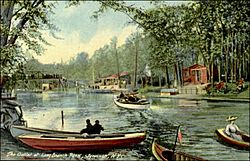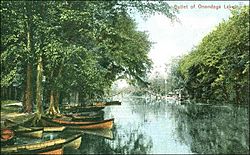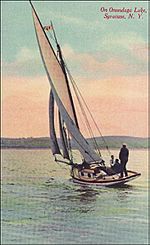Onondaga Lake facts for kids
Quick facts for kids Onondaga Lake |
|
|---|---|
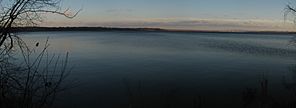 |
|
| Location | Onondaga County, New York, United States |
| Coordinates | 43°05′21″N 76°12′37″W / 43.0891802°N 76.2103857°W |
| Primary inflows | Ninemile Creek, Onondaga Creek |
| Primary outflows | Seneca River |
| Basin countries | United States |
| Max. length | 4.6 mi (7.4 km) |
| Max. width | 1 mi (1.6 km) |
| Surface area | 4.6 sq mi (12 km2) |
| Max. depth | 63 ft (19 m) |
| Surface elevation | 370 feet (110 m) |
Onondaga Lake is a lake in Central New York, right next to Syracuse, New York. The lake's southern and western sides are near factories and highways. The northern and eastern sides have parks and museums.
Even though it's close to the Finger Lakes, Onondaga Lake is not usually counted as one of them. It's a dimictic lake, which means its water completely mixes from top to bottom twice a year.
The lake is about 4.6 miles (7.4 km) long and 1 mile (1.6 km) wide. Its surface area is 4.6 square miles (12 km²). The deepest part of the lake is 63 feet (19 m), and its average depth is 35 feet (11 m). The area that drains into the lake is 642 square kilometers (248 sq mi). This area includes Syracuse, most of Onondaga County, parts of Cayuga County, and the Onondaga Nation Territory. About 450,000 people live in this area.
Onondaga Lake gets most of its water from two natural streams: Ninemile Creek and Onondaga Creek. These streams bring about 70% of the water into the lake. The Metropolitan Syracuse Wastewater Treatment Plant (METRO) adds another 20% of the water each year. No other lake in the United States gets so much of its water from treated wastewater. Other smaller streams add the remaining 10%. The lake's water gets completely replaced about four times a year, which is faster than most other lakes. The lake flows northwest into the Seneca River. This river then joins the Oneida River to form the Oswego River, which eventually flows into Lake Ontario.
The Onondaga Nation considers the lake a sacred place. After the American Revolutionary War, New York state took control of the lake from the Onondaga people. In the late 1800s, many resorts were built along the lake's beautiful shores. Today, the Onondaga Nation still has a strong cultural presence around the lake.
As the area grew with factories and cities, the lake became very polluted. Waste from homes and industries severely damaged the lake. Because of unsafe pollution levels, people were banned from harvesting ice from the lake as early as 1901. Swimming was banned in 1940, and fishing was banned in 1970 due to mercury pollution. Mercury is still a problem today. Even after the Clean Water Act was passed in 1973 and the main polluting factory closed in 1986, Onondaga Lake remained one of the most polluted lakes in the U.S. However, a 15-year cleanup program, finished in 2017, has greatly improved the lake's health. This program also includes long-term care to make sure the lake stays clean.
Contents
History of Onondaga Lake
The Lake's Ancient Roots
Onondaga Lake is a very special place for the Haudenosaunee people. This group includes the Mohawk, Onondaga, Oneida, Cayuga, and Seneca nations. According to their stories, these nations used to fight each other. But a wise leader called the Great Peacemaker brought them together at Onondaga Lake. There, they formed a new way of governing themselves.
The Haudenosaunee, also known as the "people of the longhouse," created a league based on respect and peaceful talks. The Onondaga Nation says this event was the start of "the first representative democracy in the West."
This important event was recorded in the Hiawatha belt, a special wampum belt. Its design is now used as a flag for the Haudenosaunee. This belt tells the story of the Great Peacemaker and how the league began at Onondaga Lake. Because of this, the lake became a sacred place, remembered as where peace began.
Early European Settlers Arrive
Europeans first learned about the salt springs in the area in 1654 from the Onondaga people. Jesuit missionaries visiting Syracuse around that time were the first to write about the salty springs. They called it "Salt Lake." These springs stretched for about 9 miles (14 km) around the lake. They went from today's towns of Salina through Geddes and from Liverpool to near the mouth of Ninemile Creek.
European settlers, mostly trappers and traders, came to the Syracuse area in the 1600s and 1700s. After the French and Indian War, British traders took over from the French.
British-American colonists started making salt in the late 1700s. After the United States won the American Revolutionary War, they made a deal with the Six Nations called the Treaty of Fort Stanwix in 1788. This agreement transferred the land around the lake from the Onondaga Nation to local salt makers. The deal was that the salt would be made for everyone's use.
By 1822, the lake's water level was lowered because of a lot of malaria cases. This happened after its outlet to the Seneca River was dredged. The low, swampy area, now part of downtown Syracuse, was drained.
The completion of the Erie Canal in the 1820s and the commercial production of salt led to more people settling in the area. The lake's western shore became more and more industrial throughout the 1800s.
Onondaga Lake also became a popular place for vacations. By the late 1800s, its shoreline had many hotels, restaurants, and amusement parks. The area was so popular that people traveled by train from as far as New York City to visit the lake. Fish caught from the lake were served in restaurants all over the state.
Industry and Pollution Begin
Salt brine (salty water) and limestone were important materials for making soda ash. Soda ash was used to make glass, chemicals, detergent, and paper. Because Onondaga Lake had a lot of salt brine and limestone, many factories were built along its shores. Starting in 1838, New York State allowed drilling deep wells around the lake to find the source of the brine, but they never found it.
The Solvay Process Company started drilling deep test holes south of Syracuse in 1883. Their main product was soda ash. Eventually, Solvay found salt deposits deep underground in the Tully Valley. From 1890 to 1986, over 120 wells were drilled into these salt beds. Soda ash production began in 1884. The company made about 20 tons of soda ash per day and dumped most of its waste directly into Onondaga Lake. Later, wastebeds were built along the lake's southwest side to hold these by-products. In 1907, New York State's Attorney General threatened to sue the Solvay Process Company for dumping waste directly into the lake.
As Syracuse grew in the 1900s, a lot of pollution hit the lake. Sewage, car fumes, and trash dumping caused the lake to become less popular. Fishing and swimming also declined.
In 1920, the Solvay Process Company joined with other chemical companies to form Allied Chemical and Dye Corporation. In 1950, they started making chlorine using mercury. Mercury-contaminated waste was also dumped directly into Onondaga Lake. Allied Chemical Corporation continued to let mercury into the lake. This led to the government banning fishing in 1970 because the fish were contaminated with mercury. It's estimated that Allied Chemical was dumping about 25 pounds (11 kg) of mercury into Onondaga Lake every day. In 1986, the company closed its operations in Syracuse due to new environmental laws.
In 1989, New York State sued Allied-Signal, Inc. (the new name for Allied Chemical) for polluting Onondaga Lake. They agreed to study how to clean up the lake. This study was done by Honeywell, Inc., which Allied-Signal became in 1999.
Other companies also set up along the Onondaga Creek valley from the mid-1800s to the early 1900s. Many of these companies drilled wells to get water for cooling. They used this water to keep dairy products and beer cold, store perishable goods, and control temperatures in buildings. After using the water, they dumped it into nearby streams that flowed into Onondaga Lake. This made the surface water saltier.
Parks and Fun Around the Lake
Long Branch Park
Long Branch Park is a public park in Onondaga County, New York. It's located in Liverpool near NYS Route 370. The park is on the northern shore of Onondaga Lake. It's separate from Onondaga Lake Park.
Onondaga Lake Park
Onondaga Lake Park is another county park. It runs along the eastern shore of the lake in Liverpool. The park has seven miles (11 km) of shoreline. It offers many areas for family picnics, including spots in Willow Bay and Cold Springs.
Onondaga Lake Park Marina
The Onondaga Lake Park Marina is located on Onondaga Lake Parkway in Liverpool. It's a great place for boats.
Wegmans Good Dog Park
The Wegmans Good Dog Park was the first of its kind in Central New York. It's in the Cold Springs Mud Lock part of Onondaga Lake Park. This park is open every day, all year, from sunrise to sunset.
Dogs can run without leashes in a 40,000 square foot (3,700 m²) fenced area. This area has fun things like tunnels, jumps, bridges, and even red fire hydrants.
The park entrance is at 49 Cold Springs Trail in Liverpool, off NYS Route 370. A $1 donation per person is suggested at the main gate. The park is kept up by private donations.
Museums Near the Lake
Skä•noñh Center
The Old French Fort at the Mission of Sainte Marie was an early attempt by French Jesuits and colonists to build a base in Central New York. In the 1930s, a "replica" of the fort was built. Later research showed it wasn't very accurate.
In the 1980s, they decided to build a more historically correct version. A visitor's center was also added. This center displays old artifacts found in the area. It's a "hands-on" living museum.
Since 2013, the Onondaga Historical Association (OHA) has managed this site. They plan to turn it into a Haudenosaunee (Iroquois) Heritage Center. It will be called the Skä•noñh Center – Great Law of Peace Center. Skä•noñh is an Onondaga greeting that means "Peace and Wellness."
Salt Museum
The Salt Museum was built around an old chimney from a salt boiling block. It opened in 1933 during the Great Depression. It teaches visitors about the history of salt production in the area.
Events at Onondaga Lake
Onondaga Lake is a popular spot for many events throughout the year. These events often include outdoor activities and community gatherings.
Pollution and Cleanup Efforts
Sewage Wastewater Pollution
For many years, Syracuse dumped human waste into Onondaga Lake with little treatment. Before many people lived in the area, the lake had low levels of aquatic plants.
However, high levels of ammonia and phosphorus from sewage caused too much algae to grow. When this extra algae dies, bacteria use up a lot of oxygen to break it down. This leads to low-oxygen conditions, which can harm fish and plants, especially in deeper parts of the lake. This process is called eutrophication.
Combined sewer overflow (CSO) also adds pollution. In some parts of Syracuse, sewers carry both sewage and stormwater. During dry weather, all sewage goes to Metro for treatment. But during heavy rain or melting snow, there's too much water for the sewers. They overflow, sending a mix of runoff and sewage into Onondaga Creek and Harbor Brook. This mix eventually reaches Onondaga Lake, causing concerns about bacteria. In the 1960s, Syracuse had ninety places where CSO could flow into the lake's streams.
Chemical Pollution in the Lake
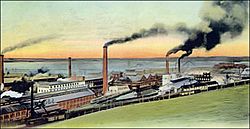
The Allied Chemical Corporation greatly contributed to chemical pollution in Onondaga Lake. The lake's surface water was found to have mercury. The lake bottom sediments were polluted with chemicals like polychlorinated biphenyls (PCBs), pesticides, creosotes, and heavy metals such as lead, cobalt, and mercury. Other harmful chemicals like polycyclic aromatic hydrocarbons (PAHs) and chlorinated benzenes were also found.
Some of these chemicals were dumped directly into the lake. Others seeped in from toxic waste sites or from the Solvay wastebeds near the lake's southwest end. Before Allied Chemical closed in 1986, about 6 million pounds (2.7 million kg) of salty waste, including chloride, sodium, and calcium, were dumped into the lake.
Mercury contamination has been a major problem. Between 1946 and 1970, Allied Chemical and Dye Corporation released 165,000 pounds (75,000 kg) of mercury into Onondaga Lake. A study in 2002 found mercury pollution throughout the lake, especially in the sediments of the Ninemile Creek delta and the southwest part of the lake. Because of mercury, fishing was banned in 1970.
In 1999, the New York State Department of Health (NYSDOH) said it was okay to eat bass, white perch, and catfish from Onondaga Lake again. However, they still advised against eating walleye. Women of childbearing age, babies, and children under 15 were told not to eat any fish from the lake. In 2007, the NYSDOH updated its advice. They said not to eat largemouth and smallmouth bass over 15 inches (38 cm) long. They also said not to eat any walleye, carp, channel catfish, or white perch. For other fish like brown bullhead and pumpkinseed, they advised no more than four meals per month.
Mudboils and Sedimentation
About 18 miles (29 km) south of Syracuse, in the Tully Valley, there are unique natural features called mudboils. These mudboils cause a lot of sediment (dirt and tiny particles) to enter Onondaga Lake. The sediment flows into Onondaga Creek, which then carries it north into the lake. Too much sediment makes the water quality worse. It reduces how clear the water is and harms the living spaces for water insects, fish spawning, and plants.
Legal Actions and Cleanup Efforts
Cleaning Up Sewage Pollution
The first steps to control sewage pollution began in 1907. The Syracuse Interceptor Sewage Board was created to deal with sewage problems in Onondaga Creek and Harbor Brook. In 1960, Onondaga County built the Metropolitan Sewage Treatment Plant ("Metro") on the lake's south shore.
In 1987, the Atlantic States Legal Foundation (ASLF) sued Onondaga County. They claimed that Metro and the combined sewer overflow (CSO) were breaking federal water pollution rules. New York State joined the lawsuit, saying the county also broke state environmental laws.
In 1990, the U.S. Congress created the Onondaga Lake Management Conference. This group was told to create a plan to clean up and manage Onondaga Lake. Their biggest job was to complete the Onondaga Lake Management Plan.
In 1997, New York State and ASLF agreed on a plan called the Onondaga Lake Amended Consent Judgement (ACJ). This plan set a timeline for improving wastewater treatment and collection. The ACJ was a multi-year program to make the lake's water cleaner and follow state and federal water quality rules by December 1, 2002. ACJ projects focused on wastewater treatment, the sewer system, and monitoring the lake and its streams. A federal judge approved the ACJ in 1998.
By 2004, Metro greatly reduced its ammonia discharge. By 2005, the amount of ammonia released each year dropped significantly. Since 2007, Onondaga Lake has met the water quality standards for ammonia. It was officially removed from the state's list of polluted waters for that issue in 2008.
The ACJ also had other successes. Between 1993 and 2006, phosphorus discharges from Metro decreased by 86%. For CSO pollution, the ACJ required that by 2010, the county would stop or treat 95% of the CSO volume during heavy rain and snowmelt.
Cleaning Up Chemical Pollution
In 1989, New York State sued Allied-Signal, Inc.. The lawsuit aimed to make the company clean up the dangerous waste it had dumped into and around the lake. In 2005, the New York State Department of Environmental Conservation (NYSDEC) and the US Environmental Protection Agency (EPA) announced the cleanup plans for Onondaga Lake. A federal court approved a Consent Decree in 2007. This agreement made Honeywell International, Inc. responsible for carrying out the cleanup plan for the polluted sediments at the bottom of the lake. Honeywell signed the agreement that same year and started the cleanup work.
The cleanup plan involved dredging (removing) up to 2.65 million cubic yards of polluted sediments. This would create space for a cap to be built without losing any lake surface area. The plan also included building a steel barrier wall on the lake's southwest corner. This wall would stop pollution from the wastebeds from getting into the lake. Honeywell finished the second phase of this barrier wall in 2011. The estimated cost for the cleanup was $451 million.
Dredging began in July 2012. The polluted sediments were pumped from the lake bottom to a special area in Camillus, New York. The dredging finished in November 2014, a year ahead of schedule. About 2.2 million cubic yards of polluted sediment were removed.
The plan also called for a cap covering 580 acres (2.3 km²) of the lake bottom. Capping started in August 2014 and was finished in 2016. Restoring the natural habitats was completed in November 2017.
In 2015, the EPA's first review found that adding a diluted calcium nitrate solution helped control methylmercury (MeHG) in deep areas of the lake. This reduced MeHG levels throughout the lake. At depths of 10–19 meters (33–62 ft), the amount of MeHg has dropped by 97% since 2006.
Audubon New York gave Honeywell an award in 2015 for its role in "one of the most ambitious environmental reclamation projects in the United States."
As part of the cleanup, Honeywell funded and runs the Onondaga Lake Visitors Center. It opened in 2012 and provides information about the ongoing cleanup.
The Onondaga Nation is not fully happy with the cleanup plan. They say the dredging plan doesn't include all the polluted sediment. They also believe that the caps are not a permanent solution and will eventually fail. The Onondaga Nation states that New York State's goals do not include making the lake swimmable or fishable, which are goals in the Clean Water Act. The Onondaga Nation believes a full cleanup would cost much more.
Controlling Sedimentation
Since 1992, the Onondaga Lake Partnership has worked with the United States Geological Survey (USGS) to reduce sediment. They have diverted surface water away from the mudboils, built a dam on the stream from the mudboils area, and drilled wells to reduce pressure around the mudboils. These wells have greatly reduced the amount of sediment entering the lake. The average amount of sediment dropped from 30 tons per day to just 1 ton per day.
Onondaga Land Rights Claim
The lake is also part of a land rights claim filed by the Onondaga Nation on March 11, 2005. The Onondaga Nation wants to protect the natural resources in and around their land. They also want to secure their rights to hunt, fish, and gather resources for their cultural needs. According to Sid Hill, the Tadodaho (leader) of the Iroquois, the Onondaga people want the water, land, and air to be returned to how they were before New York State took them illegally in the 1700s and 1800s. Hill believes the lake's polluted state shows that New York State and federal authorities cannot properly care for the land and water. A federal judge dismissed the land rights claim on September 22, 2010.
Improvements in Fishing
Records from the 1600s show that Onondaga Lake used to have a cold-water system that supported certain types of fish. Around the late 1800s, the lake became polluted. Fish like the American eel, Atlantic Salmon, and Whitefish declined. Their populations decreased because of rising water temperatures due to severe pollution and human activities. Even though these fish species are starting to return to the lake, the evidence shows that pollution directly harmed the fish that once lived there.
A survey in 1928 found only ten fish species left in the lake. After cleanup and restoration efforts, researchers found a total of 54 fish species between 1990 and 1999. The quality of sport fishing for large and small-mouth bass has become nationally recognized.
In 2011, Brown Trout were listed among Onondaga Lake's common species. Lake Sturgeon, which were stocked in nearby Oneida Lake, had also returned. In recent years, areas around the lake have become a winter home for bald eagles. This shows that the fishing is good, providing plenty of food for the eagles.
|







